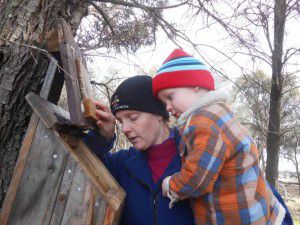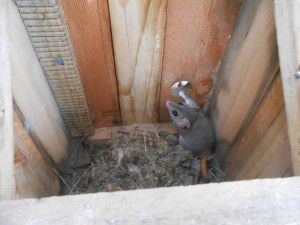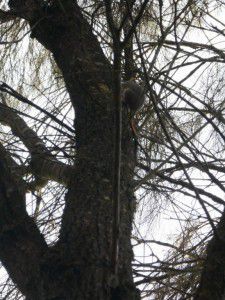It was a cold mid-winters day in Katanning, as we quietly went over the fence, through the bush and up to that special sheoak tree.
The wool that had been placed on the ground at the base of the tree was all but gone. I carefully opened the lid on the nesting box. Peering inside, it was clear we had a resident. A beautiful soft mound of wool, feathers, leaves and twigs had been built, almost pyramidal in shape.

Checking the nesting box
And then, movement. A twitch of a nose poking out of a hole built through the pyramid. Could it be? Then before my eyes, a red tailed phascogale emerged, looked up, scurried out of the access hole and up the tree.

The Red Tailed Phascogale who made a home in the nesting box
Safely above our heads, the beautiful creature – like a large mouse with a magnificent red tail splaying out into a dark brushy tip – sat still. We watched in awe, then moving slowly and carefully retreated back to the waiting ute out in the paddock.

Can you see the splendid red tail hanging down? Hint: About two thirds of the way up the tree, on the right.
As we drove away, the excitement bubbled up out of us. We had just seen an endangered Red Tailed Phascogale (
Phascogale calura)!! Its cuteness, agility, size, health and beauty had us enamoured. Often they’re only seen when brought in dead by cats – their main predator. But this one was very much alive.
Once wide-spread across southern Australia, the Red Tailed Phascogale has suffered badly from habitat clearing and introduced predators such as the cat. Now their main population is limited to a roughly triangular zone stretching from Narrogin in the north to Katanning in the south, and east towards Lake Grace. Knowing we had bush on our farm suitable for Phascogales – sheoak and wandoo woodland – and having had a report of one on a neighbouring farm, we installed the nest box (built through a Landcare workshop session) to help these little guys out with a home. Females live for three years, males only one.
Since then, we’ve fenced off further bushland from livestock, and installed two more nest boxes. Supported through the Katanning Landcare Centre, many other farmers around the district are doing the same. One landholder installed a night vision camera, and got amazing footage of Red Tailed Phascogales darting around hunting insects – a splendid sight that was almost lost to extinction.
Red Tailed Phascogales are now listed as ‘conservation dependent’ nationally.
Wouldn’t it be great if we could get them off the list completely – will you help us?
Leave A Comment